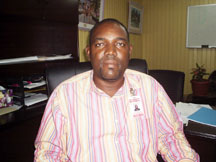At 30, critical parts sag or are worn out and for some there is a feeling of trepidation when traversing it. But the Demerara Harbour Bridge (DHB) is not ready to be written off just yet and replacement of worn-out decking plates on the structure is expected to begin shortly.

It is a belated but much needed exercise, given the rapid deterioration of decking plates that were sourced locally. The steel for the new ones is coming from Miami, General Manager of the DHB, Rawlston Adams said, and is much stronger than the one obtained here.
For the structure, which is a vital link between the East and West Demerara, facilitating the movement of thousands of commuters and vehicles each day, it was allowed to deteriorate to such an extent that President Bharrat Jagdeo dubbed its state as “almost criminal”. Shortly after the President made his observation in an impromptu visit to the bridge, money for repairs was allocated.
Adams, in a recent interview with Stabroek News said that $650M was allocated for the repairs and this entails the supply of 2000 decking plates and the procurement of critical spares. A contract has been signed with Courtney Benn Contracting Services for the supply of the 2000 deck plates. Adams said that the ship with the steel for the fabrication of the plates was expected to arrive in the country last week and the Demerara Harbour Bridge Corporation (DHBC) expects the company to start delivering the plates within a week to ten days after for immediate installation. They will be supplied in tranches and all the 2000 plates are expected to be completely installed within three to four months.

Adams noted that the plates will be installed during light traffic periods and during the bridge retraction, with work also scheduled during the weekends particularly on Sundays, when the traffic is light. He emphasized that the bridge would not be closed to facilitate the installation. The critical plates needing to be replaced have already been identified. There will be three welding crews at various points.
Apart from the purchase of the decking plates, the money allocated would also be used to procure critical spares such as transoms, winches and other items that would be needed in the event of an emergency. The General Manager pointed out that the Corporation has been continuing to weld and replace decks and do other works with the resources available and work had not stopped. “Those works were done and continue to be done as part of our work”, he asserted.
Meantime, quizzed on the decking plates that were sourced locally and which came under criticism from President Jagdeo because they only lasted for six months, Adams said that the material was “not the right material in terms of structural strength”. He commented that due to the kind of loading, in terms of trucks, being seen by the bridge, the decking plates “failed” six months after installation. The General Manager declared that it must be understood that the bridge could not have been left as it was so what was available had to be utilized until the right material was procured. He declined to name the supplier for the decking plates acquired locally.
Jagdeo had also said that he was told that the plates could not be sourced internationally and on this, Adams stated that he was unable to say who advised the President in that regard. While admitting that the DHBC management would have made the decision and stating that he was only appointed General Manager on April 14 “so I am not too sure what previous management was looking for”, Adams posited that at the time they were probably unable to get the right materials.
He stated that from the time he assumed his current job, they began looking for the appropriate materials. He said that the new decking plates are made out of steel but with a different structure and property. Adams declared that “it will significantly improve the life of the bridge” but remarked that it must be made clear that the bridge had in excess of 7900 decks and this input will see 2000 plates being installed. ”We still have to continue once that is finished… to change those that would have now gone bad, so it will be a cycle of maintenance”, he commented. This newspaper was shown a sample of the new decking plates and they were thicker that the ones sourced locally.
Seven to 10 years
Earlier, in October, Minister of Transport, Robeson Benn had said that the government needs to keep the bridge going for another seven to ten years and asked about this, Adams said that relatively speaking the works being done will enable the bridge to be around for the period. “We expect the bridge to last for the next seven to ten years before we look at putting in something new”, he said adding that it does not say that the current repairs will extend the life of the bridge for seven to ten years. Pointing to the age of the bridge, he stated that for a 30-year-old steel bridge, apart from the deteriorating decking plates, all the other structural components are sound.
He disclosed that the feasibility study for a new bridge has not yet started though an evaluation has been completed and they are now waiting for approval to go ahead and start the study.
The current injection of funds is the second major allocation given to the bridge for this year. In July, ‘Operation Transom’ was unveiled and this involved work on the retractor span, and the rehabilitation of the ‘chairs’ which support the transoms (the beams for the bridge). The work also included the rehabilitation of 70 pontoons, replacing one-extra large pontoon and three large pontoons for the bridge’s high span and retractor spans and replacing 320 deck plates. These works were expected to cost some $555 million. Resurfacing of the structure at a cost of $42M was also done.
At present, a scale for the weighing of heavy vehicles at the western end of the bridge is being constructed and while the General Manager was unable to give an update on it as that project was being supervised by the Public Works Ministry, he noted that the scale had been installed and the approach road needs to be done.
Since Adams assumed his position, there have been several changes with regards to traffic management that motorists have commended. Currently and this is going to be a permanent feature, the bridge is opened to two- lane traffic heading east from 7am to 7:20am on weekday mornings. The slow flow of traffic during this peak period had been a feature that left many frustrated but this had reduced considerably. Additionally, at the toll booths, barriers have been constructed to prevent errant drivers from forcing their way to the front of the line. This feature has also been met with praise.
Adams, during the interview, also took the opportunity to apologize to commuters for the extended disruption a few Sundays ago, when the bridge remained closed for several hours. This he said was due to unforeseen circumstances, which occurred when workers were replacing a transom. He also appealed to drivers to adhere to the speed limits and desist from overtaking while traversing the bridge.
Commissioned on July 2, 1978 and originally built to last ten years, the DHB is a 6,074-foot (1,851 m) long floating bridge. Construction of the bridge began in May 1976. It was repaired in 1998 through a major European Union project at a cost of US$10 million, which extended its years of service. The bridge’s superstructure is supported by more than 100 pontoons and comprises 61 spans.
It has a pedestrian foot walk and a raised section, under which small vessels pass while the retractor span allows for the passage of large vessels.





